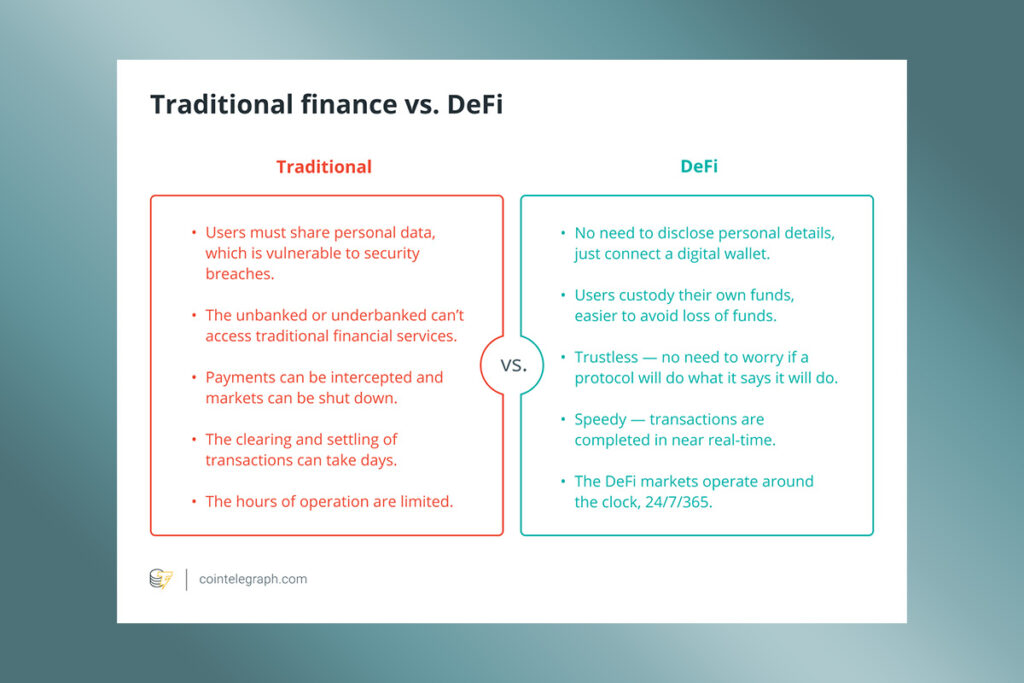By simplifying the complexity of DeFi and making it more accessible to a broader user base, DeFi protocols can pave the way for a more inclusive and efficient decentralized financial ecosystem.
Interview with Nolus: Tackling Market Volatility, Liquidity Issues, and DeFi Complexity
Decentralized finance (DeFi) has emerged as a transformative force in the financial landscape, offering various innovative financial products and services. However, the nascent DeFi industry faces several hurdles like market volatility, liquidity issues, product complexity, and compliance risks that must be addressed to ensure its long-term sustainability and growth.
Despite these challenges, the DeFi industry holds immense potential to revolutionize the financial sector by providing greater accessibility, efficiency, and transparency. To unlock this potential and foster continued innovation, DeFi protocols must prioritize user-friendliness and robustness.
Kamen Trendafilov, co-founder and CEO of Nolus, a pioneering DeFi protocol, sheds light on this critical aspect of DeFi’s development.
Cointelegraph: What are key trends do you believe will shape the future of DeFi?

Kamen Trendafilov: The future of DeFi is poised to be influenced by several critical trends. First and foremost, we’re anticipating an increase in regulation and compliance. As DeFi continues to grow, it’s naturally attracting more regulatory scrutiny, which is expected to lead to clearer guidelines and standards. This could pose challenges but also opportunities for greater stability and credibility within the sector.
Another significant trend is the increasing institutional adoption. We’re seeing a growing interest in DeFi from traditional financial institutions and institutional investors driven by its potential for high returns and efficient financial transactions. This influx of institutional participation will likely increase liquidity and lead to more robust DeFi infrastructure development.
Security is a paramount concern, and we expect enhanced measures to be a key focus. Various scams and hacks have plagued the DeFi space, so there’s a growing emphasis on improving smart contract auditing, developing better insurance mechanisms, and enhancing wallet security technologies.
Moreover, scalability and interoperability are areas where significant advancements are expected. The future of DeFi likely includes faster and cheaper transactions, along with seamless integration between different blockchains.
CT: What are the biggest challenges facing the DeFi industry today?
KT: The burgeoning DeFi industry, despite its transformative potential, faces several formidable hurdles. One of the most pressing concerns is the inherent volatility of cryptocurrencies, which can wreak havoc on the stability and viability of DeFi projects. This volatility is compounded by liquidity issues, which can plague certain platforms and hinder user experience.
Another significant hurdle is the complexity and accessibility of DeFi products. The technical nature of blockchain and DeFi can be daunting for the average user, creating a barrier to entry for many who are not deeply versed in this technology.
Finally, we must address the compliance and legal risks. Due to the anonymous or semi-anonymous nature of many DeFi platforms, there is a risk of inadvertently facilitating illegal activities. This not only poses legal risks but also attracts further regulatory scrutiny, which can impact the growth and reputation of the DeFi ecosystem.
CT: How can these challenges be addressed to ensure the long-term sustainability and growth of the sector?
KT: The DeFi industry needs to adopt a holistic approach. Starting with market volatility and liquidity issues, we can enhance stability by creating more diversified financial applications. This diversification, alongside implementing more sustainable incentives for liquidity provision, can help stabilize the market. Furthermore, integrating traditional financial instruments and risk management tools into DeFi platforms can offer a buffer against market volatility.
Regarding user education and simplification, it’s imperative to make DeFi more accessible and less intimidating for new users. This involves simplifying user interfaces and investing in comprehensive educational resources.
Lastly, for legal and compliance frameworks, the sector must establish robust systems tailored specifically to DeFi. This includes implementing appropriate identity verification processes to curb illicit activities while maintaining transaction transparency. It’s crucial to balance these measures with respecting user privacy. Collaborating with regulatory bodies to develop clear guidelines can help DeFi projects navigate the complex legal landscape, ensuring compliance and fostering a more secure and trustworthy ecosystem.
CT: What role do you see Nolus playing in the future of DeFi?

KT: Nolus is strategically positioned to address some of the most pressing challenges in the DeFi space. Our primary focus is on addressing the issues of market liquidity inefficiencies, which are critical for the stability and growth of DeFi.
Furthermore, we are committed to enhancing the user experience within DeFi. Our goal is to make DeFi accessible and intuitive for tech-savvy individuals and a broader audience.
Lastly, we’re focusing on scalability while ensuring seamless interoperability. This technical advancement is crucial for facilitating smoother and more versatile DeFi operations, catering to a broader range of applications and users.
CT: How does Nolus differentiate itself from other DeFi protocols?
KT: Nolus stands out in the DeFi space through several innovative approaches. Firstly, the protocol offers up to 150% financing on the initial investment. This is a significant departure from the norm in lending platforms where substantial overcollateralization is usually required. This model enables users to obtain more funding compared to the collateral they provide, enhancing their investment capacity.
We’ve focused on reducing the risk of margin calls, a critical concern in leveraged investments, especially in the volatile crypto market. By lowering this risk, Nolus becomes a more attractive option for users who are apprehensive about the impacts of sudden market fluctuations on their investments.
CT: Can you explain the Nolus business model in more detail?

KT: Nolus addresses a major challenge in crypto lending by tackling stringent overcollateralization requirements, historically limiting capital efficiency. Offering more flexible lending options, Nolus aims to create a fluid and efficient capital market in the crypto space, drawing inspiration from traditional finance lease products. The protocol’s leasing concept allows users to access assets, pay a fraction upfront, utilize them during the lease, and gain ownership after repayment — an innovative approach in the DeFi sector that lacks organized and familiar financial products.
Technologically, Nolus operates on a semi-permission proof-of-stake (PoS) blockchain developed using the Cosmos SDK and a CosmWasm smart contract engine. This setup is not only robust but also ensures a fair value distribution from transactions between validators and the protocol, creating an alternative revenue stream for market participants.
A key feature of Nolus is its core focus on interoperability. The protocol can seamlessly connect with various liquidity hubs without causing fragmentation of assets across chains. This is facilitated by its ability to swap any asset instantaneously on any integrated decentralized exchange (DEX), which is a significant advantage for liquidity providers and borrowers alike.
Lastly, Nolus distinguishes itself by not following a traditional hub and spoke model. It utilizes Inter-Blockchain Communication (IBC) and Interchain Accounts for interacting with foreign chains, orchestrated in real-time through a smart contract on Nolus.
CT: How does Nolus prepare for potential market downturns to ensure the stability of the protocol and protect user funds?
KT: Nolus possesses the ability to seamlessly tap into a variety of liquidity sources across different blockchain networks. Its advanced architecture allows it to leverage the existing liquidity in various hubs, enhancing its resilience to market fluctuations. This ensures that swaps can be executed with minimal price impact and that liquidations occur without creating deficits. Additionally, Nolus is equipped with a system-controlled platform reserve, which acts as a buffer against any inefficiencies that may arise.
In the event of a notable decrease in asset prices, the system will not initiate immediate full liquidation of leased assets. Instead, it will only liquidate a small portion of the asset to restore leases to healthy levels. Users will begin to experience losses only after the asset price drops by more than 50%, provided they have not repaid their outstanding debt.
CT: What is the role of the Nolus token (NLS) in the protocol’s ecosystem?
KT: The NLS token serves as the fundamental unit of value within the network, powering various functionalities that underpin the Nolus protocol’s effectiveness and sustainability.
At the heart of the NLS token’s utility lies its role as the primary medium for transaction and network fees. Users pay these fees in NLS to facilitate their interactions within the Nolus ecosystem, whether it’s initiating a lease, redeeming assets, or participating in governance activities. These fees are then distributed among validators and delegators, the dedicated individuals who maintain the network’s integrity and security.
CT: What are Nolus’s plans for expansion and growth?
KT: Nolus has made significant progress in broadening the variety of DeFi services, processing $6 million in transactions and achieving $3 million in total value locked (TVL) in just four months. Over 2,500 DeFi lease positions have been initiated, totaling $4 million. Despite higher leverage than down payments, only 1% of lease positions have experienced liquidations due to Nolus’s favorable liquidation terms.
Our long-term vision for Nolus is to evolve it into a comprehensive margin protocol anchored in lending market mechanics. We strive to simplify the technological intricacies, enabling users with limited-to-no backgrounds in crypto to easily access and benefit from the capabilities of DeFi.
















Leave a comment